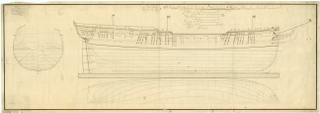Royal Navy
Commander John Ellis Watt commissioned Hart in March 1806.
On 4 August Hart captured the schooner Hannah, Eldridge, master. [lower-alpha 1]
On 6 August Hart was in company with Jason, Maria, and Tobago when they captured Hercules. [4]
Commander William Coombe was to replace Watt in early 1807. As first lieutenant of HMS Galatea, Coombe had led the boats that on 21 January 1807 captured French corvette Lynx in a notable action. The surviving British officers received promotions. Coombe was promoted to commander but received an appointment as captain of Hart, not Lynx. Hart was a lesser vessel than Lynx and Coombe complained to the admiral of the station and then to the Admiralty. The Admiralty reversed the appointments, which led to Coombe fighting a duel with the relegated captain. [5] Coombe commissioned HMS Heureux, the former Lynx, in April 1807. [lower-alpha 2]
It is not clear when Coombe replaced Watt. Prize money notices are ambiguous.
On 21 September Hart, Commander William Coombe, captured the Danish brig Adventure, Colin, master. [6]
Galatea and Hart, Commander Coombe ("Deceased"), shared in the prize money for the capture on 1 October 1807 of the schooner John and Joseph, Hansen, master. [7]
On 4 October, Hart. Commander Watt, was in company with Jason, Maria, and Pert when they captured the schooner Rebecca. [8] [lower-alpha 3]
Cerberus, and Hart, William Coombe ("late Commander"),shared the prize money for the galiot Mary, Durham, master, captured on 10 October. [7]
Hart, Latona, Circe, Galatea, Cerberus, Cygnet, and Pert shared in His Majesty's grant for the Danish schooner Danske Patriot, Outerbridge, master, captured on 20 October. The prize money notice gave the name of Hart's commander as William Coombe. [lower-alpha 4]
On 15 December 1807 HMS Fawn arrived at Barbados with the news of war with Denmark. Admiral Cochrane immediately set sail for the Danish West Indies in his flagship, HMS Belleisle, together with a squadron including Prince George, Northumberland, Canada, Ramillies, Cerberus, Ethalion, and a number of other vessels, including Hart. The expedition included troops from the 70th and 90th Regiments of Foot under the overall army commander, General Henry Bowyer. [11]
St Thomas surrendered on 22 December and St Croix on 25 December. [11] A prize money notice in the London Gazette in 1816 gives a list of the vessels, and the army units that participated in the campaign. [lower-alpha 5]
Hart no longer appeared in prize money or other notices in the London Gazette for events after December 1807.








